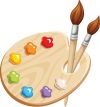Performing art
The performing arts are arts such as music, dance, and drama which are performed for an audience. It is different from visual arts, which is the use of paint, canvas or various materials to create physical or static art objects. Performing arts include a range of disciplines which are performed in front of a live audience, including theatre, music, and dance.
Theatre, music, dance and object manipulation, and other kinds of performances are present in all human cultures. The history of music and dance date to pre-historic times whereas circus skills date to at least Ancient Egypt. Many performing arts are performed professionally. Performance can be in purpose built buildings, such as theatres and opera houses, on open air stages at festivals, on stages in tents such as circuses and on the street.
Live performances before an audience are also a form of entertainment. The development of audio and video recording has allowed for private consumption of the performing arts. The performing arts often aims to express one's emotions and feelings.
See also Spanking in performing arts and/or Performance art
Performers
Artists who participate in performing arts in front of an audience are called performers. Examples of these include actors, comedians, dancers, magicians, circus artists, musicians, and singers. Performing arts are also supported by workers in related fields, such as songwriting, choreography and stagecraft. Performers often adapt their appearances, such as with costumes and stage makeup, stage lighting, and sound.
Types
Performing arts may include dance, music, opera, theatre, musical theatre, magic, illusion, mime, spoken word, puppetry, circus arts, professional wrestling, and performance art.
There is also a specialized form of fine art in which the artists perform their work live to an audience. This is called performance art. Most performance art also involves some form of plastic art, perhaps in the creation of props. Dance was often referred to as a plastic art during the Modern dance era.
Theatre
Theatre is the branch of performing arts concerned with acting out stories in front of an audience, using a combination of speech, gesture, music, dance, sound, and spectacle. Any one or more of these elements is considered performing arts. In addition to the standard narrative dialogue style of plays, theater takes such forms as plays, musicals, opera, ballet, illusion, mime, classical Indian dance, kabuki, mummers' plays, improvisational theatre, comedy, pantomime, and non-conventional or contemporary forms like postmodern theatre, postdramatic theatre, or performance art.
Dance
In the context of performing arts, dance generally refers to human movement, typically rhythmic and to music, used as a form of audience entertainment in a performance setting. Definitions of what constitutes dance are dependent on social, cultural, aesthetic, artistic, and moral constraints and range from functional movement (such as folk dance) to codified, virtuoso techniques such as ballet.
There is one another modern form of dance that emerged in 19th- 20th century with the name of Free dance style. This form of dance was structured to create a harmonious personality which included features such as physical and spiritual freedom. Isadora Duncan was the first female dancer who argued about "woman of future" and developed a novel vector of choreography using Nietzsche's idea of "supreme mind in free mind".
Dance is a powerful impulse, but the art of dance is that impulse channeled by skillful performers into something that becomes intensely expressive and that may delight spectators who feel no wish to dance themselves. These two concepts of the art of dance—dance as a powerful impulse and dance as a skillfully choreographed art practiced largely by a professional few—are the two most important connecting ideas running through any consideration of the subject. In dance, the connection between the two concepts is stronger than in some other arts, and neither can exist without the other.
Choreography is the art of making dances, and the person who practices this art is called a choreographer.
Music
Music is an art form that combines pitch, rhythm, and dynamics to create sound. It can be performed using a variety of instruments and styles and is divided into genres such as folk, jazz, hip hop, pop, rock, etc. As an art form, music can occur in live or recorded formats and can be planned or improvised.
As music is a protean art, it easily coordinates with words for songs as physical movements do in dance. Moreover, it has the capability of shaping human behaviors as it impacts our emotions.
Chat rooms • What links here • Copyright info • Contact information • Category:Root
